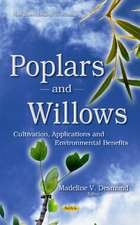Biotechnology and Production of Anti-Cancer Compounds
Editat de Sonia Maliken Limba Engleză Hardback – 3 mai 2017
| Toate formatele și edițiile | Preț | Express |
|---|---|---|
| Paperback (1) | 946.87 lei 43-57 zile | |
| Springer International Publishing – 8 aug 2018 | 946.87 lei 43-57 zile | |
| Hardback (1) | 952.89 lei 43-57 zile | |
| Springer International Publishing – 3 mai 2017 | 952.89 lei 43-57 zile |
Preț: 952.89 lei
Preț vechi: 1162.06 lei
-18% Nou
Puncte Express: 1429
Preț estimativ în valută:
182.34€ • 190.85$ • 151.76£
182.34€ • 190.85$ • 151.76£
Carte tipărită la comandă
Livrare economică 31 martie-14 aprilie
Preluare comenzi: 021 569.72.76
Specificații
ISBN-13: 9783319538792
ISBN-10: 3319538799
Pagini: 362
Ilustrații: XV, 328 p. 53 illus., 36 illus. in color.
Dimensiuni: 155 x 235 x 21 mm
Greutate: 0.66 kg
Ediția:1st ed. 2017
Editura: Springer International Publishing
Colecția Springer
Locul publicării:Cham, Switzerland
ISBN-10: 3319538799
Pagini: 362
Ilustrații: XV, 328 p. 53 illus., 36 illus. in color.
Dimensiuni: 155 x 235 x 21 mm
Greutate: 0.66 kg
Ediția:1st ed. 2017
Editura: Springer International Publishing
Colecția Springer
Locul publicării:Cham, Switzerland
Cuprins
Chapter 1 Medicinal Plants: Ethno-Uses to Biotechnology Era.- Chapter 2 How Plants Can Contribute to the Supply of Anti-Cancer Compounds.- Chapter 3 Cancer and Biotechnology: A Matchup that Should Never Slowdown.- Chapter 4 Plant Derived Compounds with Anti-Cancer Properties: From Folklore to Practice.- Chapter 5 Anticancer Drugs from Plants.- Chapter 6 Cambial Meristematic Cells: A Sustainable Platform for the Production of Plant-Derived Anti-Cancer Crugs.- Chapter 7 Family Fabaceae: A Boon for Cancer Therapy.- Chapter 8 Small Cells For Big Ideas: The Cytotoxic Podophyllotoxin And The Long Journey In Discovering Its Biosynthetic Pathway.- Chapter 9 Hairy Root Culture for the Production of Useful Secondary Metabolites.- Chapter 10 Edible Mushrooms and Their In Vitro Culture as a Source of Anticancer Compounds.- Chapter 11 Genomics and Artificial Intelligence Working Together in Drugs Discovery and Repositioning: The Advent of Adaptive Pharmacogenomics in Glioblastoma and Chronic Arterial Inflammation Therapies.- Chapter 12 A Multiscale Haemorheological Computer-based Model of Chronic Inflammation: an in-Depth Investigation of Erythrocytes-driven Flow Characteristics in Atheroma Development.
Notă biografică
Dr. Malik has obtained her doctoral degree in Plant Biotechnology from CSIR- Institute of Himalayan Bioresource Technology, Palampur, India in July 2009. She did Masters (Gold Medalist) in Honours Botany with specialization in Plant Biotechnology and Tissue Culture in 2001 from Guru Nanak Dev University, Amritsar, India. Her basic area of research is plant secondary metabolites and genetic manipulation and she did work on several medicinal plants. After her post-doctoral studies at Brazil, Czech Republic and United Kingdom, Dr. Malik has joined as a Professor in Biology at Biological and Health Sciences Center, Federal University of Maranhão, Sao Luis since February 2015. At present she is an active member of Post-graduate research program at UFMA and actively involved in research, teaching and supervising research students at UG/PG levels. She has been awarded as FAPEMA Junior Researcher grant in August 2015. To date, Dr. Malik has published more than 20 research articles inreputed journals, 2 book chapters and several abstracts in National and International conferences/symposia. She is editorial board member and reviewer of many International Scientific Journals.
Textul de pe ultima copertă
This book discusses cancers and the resurgence of public interest in plant-based and herbal drugs. It also describes ways of obtaining anti-cancer drugs from plants and improving their production using biotechnological techniques. It presents methods such as cell culture, shoot and root culture, hairy root culture, purification of plant raw materials, genetic engineering, optimization of culture conditions as well as metabolic engineering with examples of successes like taxol, shikonin, ingenol mebutate and podophylotoxin. In addition, it describes the applications and limitations of large-scale production of anti-cancer compounds using biotechnological means. Lastly, it discusses future economical and eco-friendly strategies for obtaining anti-cancer compounds using biotechnology.
Caracteristici
Discusses the recent developments and techniques about anti-cancer drugs from plants, in vitro protocols to optimize the production and their mode of action and biosynthetic pathways Future strategies and goals to find out the ways to obtain the highly demanded anticancer compounds in an eco-friendly, economic and efficient ways Valuable content for any professional or student in the area of plant natural products, phytochemistry, pharmaceutical sciences, medicines, and drug discovery Includes supplementary material: sn.pub/extras








